Day 1/4 Marcus Nash Norfolk Trip
Around the Wells Area.
The main focus of the day was Yellow-browed Warblers and we were lucky to encounter them on at least 6 occasions, with good views on 2 of these. More about this later.
We spent the morning in Wells Woods and the afternoon on the east side of Wells as far as Warham. After a wet start, the clouds lifted and the rest of the day was glorious sunshine and clear skies. However …. the winds were ever-present, typically 30 m.p.h., making life very difficult for us.
The main highlights were:
- My first views of the newly arrived Pink-footed Geese from Lady Ann's Drive was a brilliant start to our day.
- A migrant Short-eared Owl flew in as we watched from Wells Woods.
- Viz Mig was much in evidence - the majority of which was birds arriving from Scandinavia - mainly Thrushes, Chaffinches, Bramblings and Crossbills.
- Bird of the day was the Yellow-browed Warbler which led us a merry dance but ultimately gave us good views. The strong winds made things difficult as we followed the tit-flocks and we eventually struck lucky on the more sheltered north (seaward) side of the wood.
- A couple of excellent views of a Hobby flying overhead.
- Several good views of a ringtail Hen Harrier form the east side of Wells were much appreciated.
11th Oct 2018 – Four Autumn Days, Day 1by The Bird ID Company |
Day 1 of a four-day Autumn Tour today. After a damp and cloudy start, the skies cleared and it was bright, sunny and even quite warm. After heading out with coats and hats, we were desperately shedding layers by mid-morning! There was a rather blustery south wind all day, which meant some of the smaller birds were keeping down in cover though.
We started the day at Holkham. Parking at Lady Anne's Drive, we could hear Pink-footed Geese calling as we got out of the car and several small skeins came over up off the grazing marshes and flew off over our heads, heading out to feed from where they had probably roosted last night.
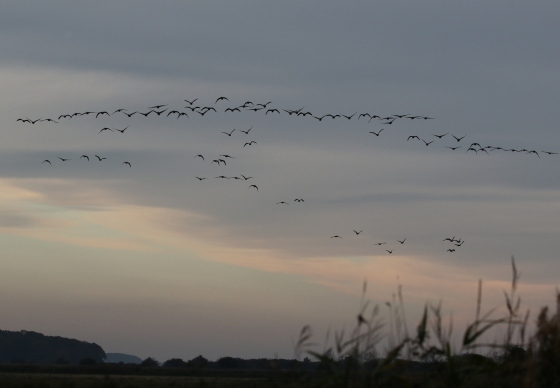
At the top of Lady Anne's Drive, we turned left on the path which runs west on the inland side of the pines. We hadn't gone more than a couple of metres before we heard a Yellow-browed Warbler calling in the trees. It came into a large oak above our heads but was high up in the leafy branches and proved impossible to see in the early gloom and wind.
A second Yellow-browed Warbler called from the holm oaks the other side of the tracks. We could see movement in the dark leaves, but it moved through too quickly to get on and both birds went quiet. We decided to try again later, if need be, when it had brightened up a bit. A good start, with two calling Yellow-browed Warblers, anyway.
A little further along the path, we came across a flock of Long-tailed Tits feeding high in the tall poplars. We stopped for a minute to see if we could find anything else with them. There were some other tits, including a couple of Coal Tits, and we heard Goldcrest and Treecreeper calling, but they moved quickly up into the tops of the pines and disappeared deeper into the trees.
At Salts Hole, there were at least six Little Grebes around the pool, back for the winter. A lone Curlew was feeding in the field behind. There were lots of Jays out today, busy collecting and stashing acorns, and we saw three flying across the back of the pool, between the trees.
We stopped again at the gate just before Washington Hide, to scan the grazing marshes. The first thing we noticed was a Short-eared Owl, circling high above the grass, flying with its distinctive stiff-winged action. It seemed nervous, looking round, possibly fresh in over the sea from Scandinavia. It flew back towards the pines and disappeared over the trees.
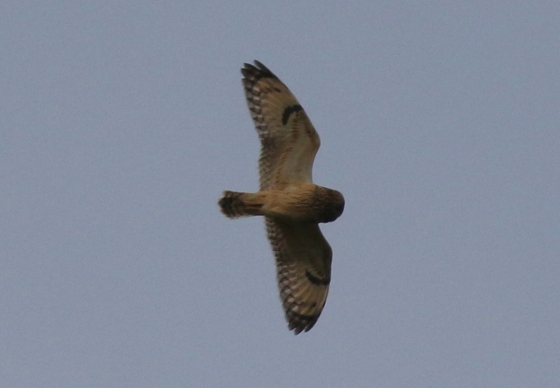
A Cetti's Warbler singing in the edge of the reedbed was good to hear, having lost most of our resident birds over the cold weather last winter. A Marsh Harrier was circling over the reedbed too, a dark chocolate brown young bird with green wing-tags, presumably tagged in the nest here. It was joined by a male and the two of them grappled talons briefly.
A Great White Egret flew in and seemed to land down on the pool, hidden in the reeds. From up on the boardwalk, we could see it perched on a post. It quickly dropped down and we watched it fishing in the shallow water from the comfort of Washington Hide. After a few minutes, it flew off round the back of the reeds.
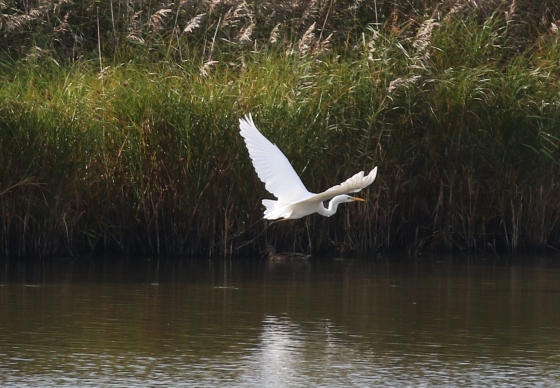
There was quite a bit of raptor activity visible from here this morning, as well as more Marsh Harriers, we saw a couple of Common Buzzards, including a rather pale bird perched out in one of the bushes on the grazing marsh, a Kestrel hovering out over the grass, and a distant Sparrowhawk circling.
As we carried on west, we could hear lots of Song Thrushes ticking in the trees - there had obviously been a large arrival of them overnight. There were Chaffinches and Bramblings calling overhead too, also freshly arrived for the winter. We heard a couple more flocks of tits from the path, but they were very hard to see in the wind, even if it was now brightening up nicely. They seemed to be hiding up in the pines or in the denser holm oaks, rather than out in the deciduous trees by the path.
At the cross-tracks, we came across another flock and could hear several Chiffchaffs calling here too, with them. Another Yellow-browed Warbler called from just into the trees, so we walked in along the path, but by the time we got round to where it had been the tits had disappeared up into the pines again.
We decided to carry on through to the north side of the pines, where it would be more sheltered from the wind. A Grey Wagtail flew over calling, but we couldn't see it from deep in the trees. As we emerged from the pines, we flushed several Song Thrushes which had been feeding down on the grass, rather grey-brown birds from the continent, duller than our resident Song Thrushes.
We heard yet another Yellow-browed Warbler calling, but this time it was out in the scattered pines in the open dunes, so we figured we had a chance of getting a look at this one. Thankfully it was quite vocal, presumably another fresh arrival, and we managed to track it down. Eventually almost all the group got a good look at it, as it flitted around among the branches. A second Yellow-browed Warbler was calling in the woods, from the denser pines beyond.
As we walked a short distance through the dunes, more Song Thrushes were coming in overhead in singles or small groups. A little flock of Bramblings flew in overhead, and we heard a small group of Crossbills glipping as they flew west over the pines, although we couldn't see them above the trees from this angle. A couple of Stonechats were perched on the top of the brambles in the dunes.
Climbing up to the top of the dunes, we stopped to scan the sea. There were quite a few birds out in the bay today - several Red-throated Divers, a Great Crested Grebe, a Guillemot, and a raft of Common Scoter. A Sandwich Tern flew past offshore, presumably a lingering summer visitor, as did a few small lines of Brent Geese, just arriving back from Russia for the winter.
It was quite amazing to just stand here looking out over the sea and just watch the birds arriving in from the continent. In particular, we saw lots of Skylarks coming in, with several flocks flying up over the dunes past us and in over the pines and other groups continuing on west just offshore. A Red Kite circling out over the beach may have been on the move too, before coming in over the dunes past us.
It was windy again back on the south side of the pines, and harder to see the birds again. We did hear several Redwings calling in the trees, and eventually got good views of one perched in the top of a pine tree. Several Song Thrushes were feeding up on the berries in a hawthorn bush, after their long journey.
Continuing on out of the pines at the west end and into the dunes, we flushed lots more Song Thrushes from the bushes as we passed. A Blackcap was calling from the brambles but we didn't see it. Up on the top of the dunes, we heard a Redstart calling in a hawthorn bush. As we walked round the back, it flew across and disappeared into a dense clump of privet. Two Grey Herons flew in high over the beach, more migrants just arriving for the winter.
Yet another Yellow-browed Warbler called and we turned to see a couple of people looking into a holly bush out in the dunes. The bird was remarkably hard to see, despite it being just a very small bush, but eventually it came out onto the more sheltered side to those members of the group who hadn't seen the Yellow-browed Warbler earlier could finally get a good look at one.
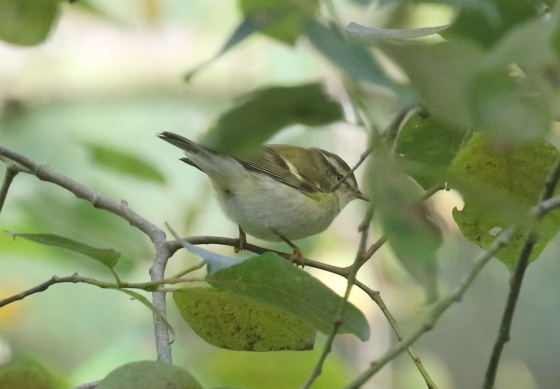
These tiny warblers breed over in Russia, just west of the Urals, and should be migrating south east to winter in Asia. Instead some Yellow-browed Warblers head off west and arrive on our shores. They used to be very rare here, but in the last twenty years have become regular visitors at this time of year. Still, they are always a pleasure to see and to marvel at their remarkable migration.
It was already after midday and stomachs were starting to rumble, so we headed back towards the car. It was lovely and sunny now, and warm too if still rather breezy. There were lots of dragonflies along the path in the more sheltered spots, Migrant Hawkers and Common Darters. We saw several butterflies out too, Red Admirals on the brambles, a Speckled Wood and a Small Copper.
A Hobby was patrolling along the edge of pines, taking advantage of the updraft from the wind, probably looking for dragonflies. A couple of times it passed by over us, and we could see its swept back pointed wings and orange trousers.
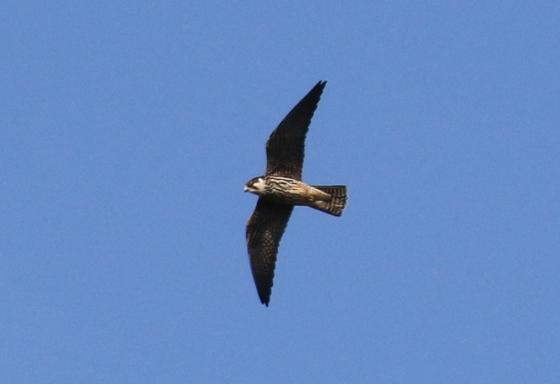
Surprise of the day was a Kingfisher which flew over our heads as we walked back along the path on the edge of the pines - not normally where you expect to see one, although they are often seen out on the marshes here. Almost back to Lady Anne's Drive, we ran into another tit flock and this time got good views of a Treecreeper climbing up a tree trunk.
It was time for a late lunch when we finally got back to the car. There were lots of Pink-footed Geese still loafing around in the fields alongside Lady Anne's Drive, while we ate. Afterwards, we set off to explore the coast east of Wells.
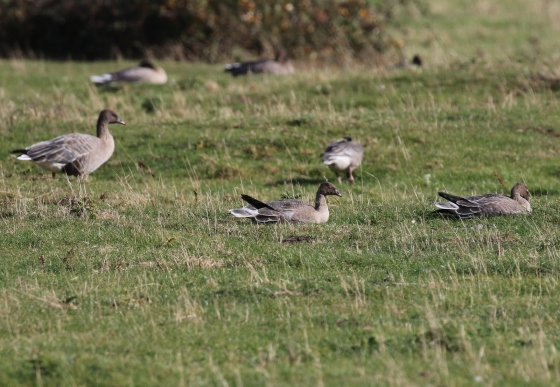
The wet fields east of Wells by the coastal path are full of wildfowl a the moment. We could predominantly see big numbers of Wigeon and Teal, the drakes still mostly in their dull eclipse plumage. In amongst them we found a single Pintail too. There are lots of geese here, but Greylags, Canadas and Egyptian Geese, although we saw plenty of Pink-footed Geese passing overhead calling.
There were a few waders in with all the wildfowl. We could see several Ruff feeding in the long grass around the pools, along with a small number of Lapwing, and three or four Black-tailed Godwits in the edge of the water, hiding in amongst all the Wigeon.
A large flock of Linnets and Greenfinches was feeding in the edge of the field nearby and further back we could see a couple of bright male Yellowhammers perched up in the bushes catching the sun. As we walked down along the track between the pools, we flushed several Reed Buntings from the wet grass. A pair of Stonechats flew along the fence line ahead of us, perching on the posts or on the bushes either side.
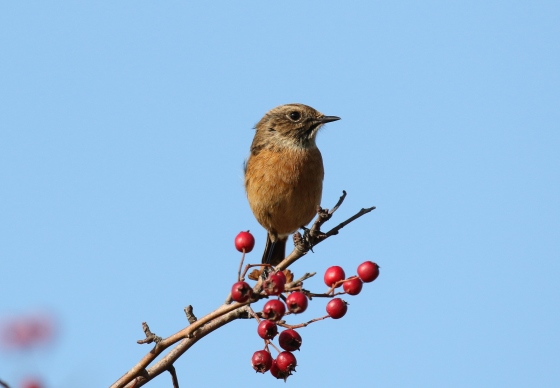
At the next pool we came too, we were looking into the sun and it was hard to keep the scopes steady in the wind. All we could find here today were Teal and Mallard, sheltering in the grass around the edges. There were lots of Little Egrets and Curlews out on the saltmarsh the other side and a couple of Redshank down in one of the muddy channels.
We decided to have a walk on along the coast path to finish the day. There were still more Song Thrushes and Chaffinches coming in, little flocks flying in over the saltmarsh and disappeared inland over the fields, or flying over our heads heading west along the coast. But there were few migrants in the bushes by the path this afternoon - as well as being windy, there were lots of people and dogs out for a walk and it was probably a bit too disturbed here.
As we walked, we stopped periodically to scan the saltmarshes. We could see several Marsh Harriers circling out in the distance, and eventually we were rewarded with a Hen Harrier too, a ringtail. We stopped and watched it as it quartered low over the marsh, flashing the white square at the base of its tail as it turned. A second Hen Harrier appeared briefly, away to the east in the distance, but didn't come our way. After a while, the first dropped down into the vegetation.
We continued on as far as Garden Drove, but the trees at the north end were more exposed to the wind, and it was hard to see anything in here. We could hear Long-tailed Tits calling and saw them as they flew out of the trees and headed off inland along the hedgerow. There were a few other tits with them, but we couldn't see anything else.
Unfortunately we didn't have much time here, as we had to get back and a couple of members of the group had decided to stop on the path where we had seen the Hen Harrier rather than continue walking, so we didn't want to leave them too long. The Hen Harrier was up again, quartering the marshes as we got back.
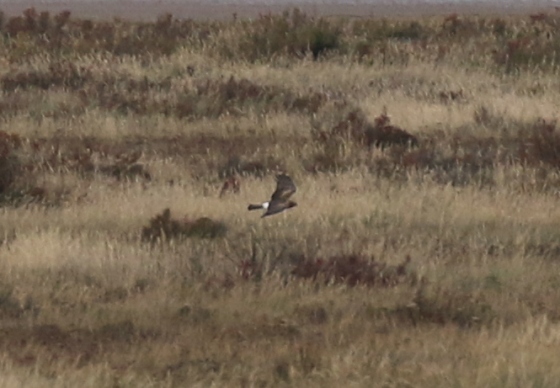
It was a nice way to end our first day out, watching the Hen Harrier out over the marshes. Let's see what tomorrow brings...
No comments:
Post a Comment
Note: only a member of this blog may post a comment.